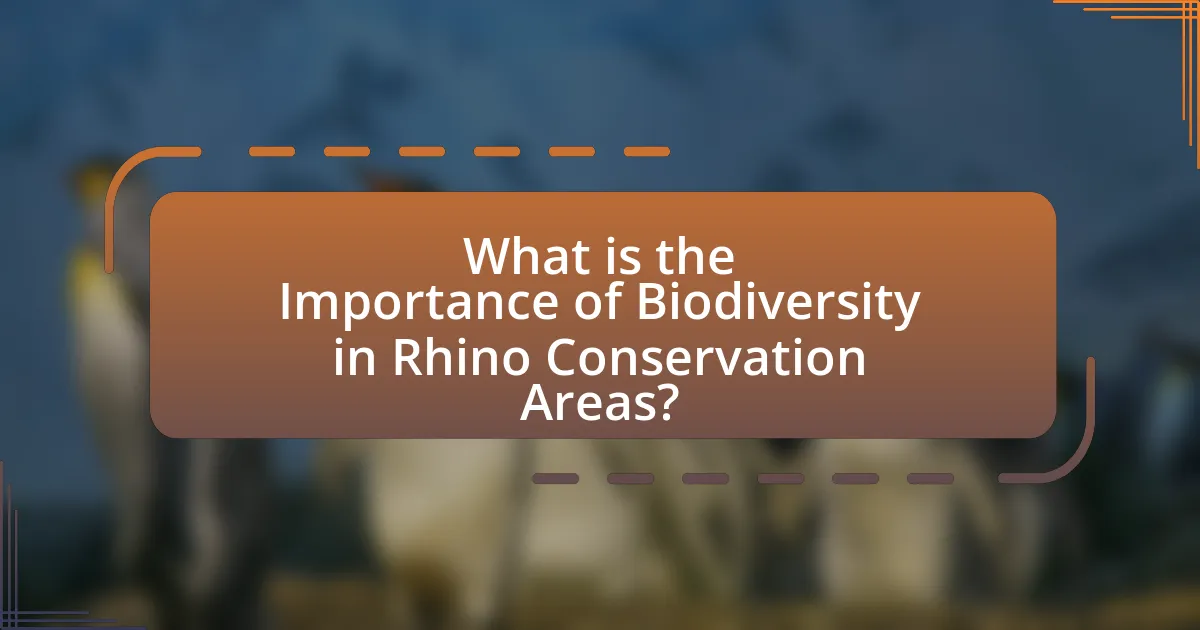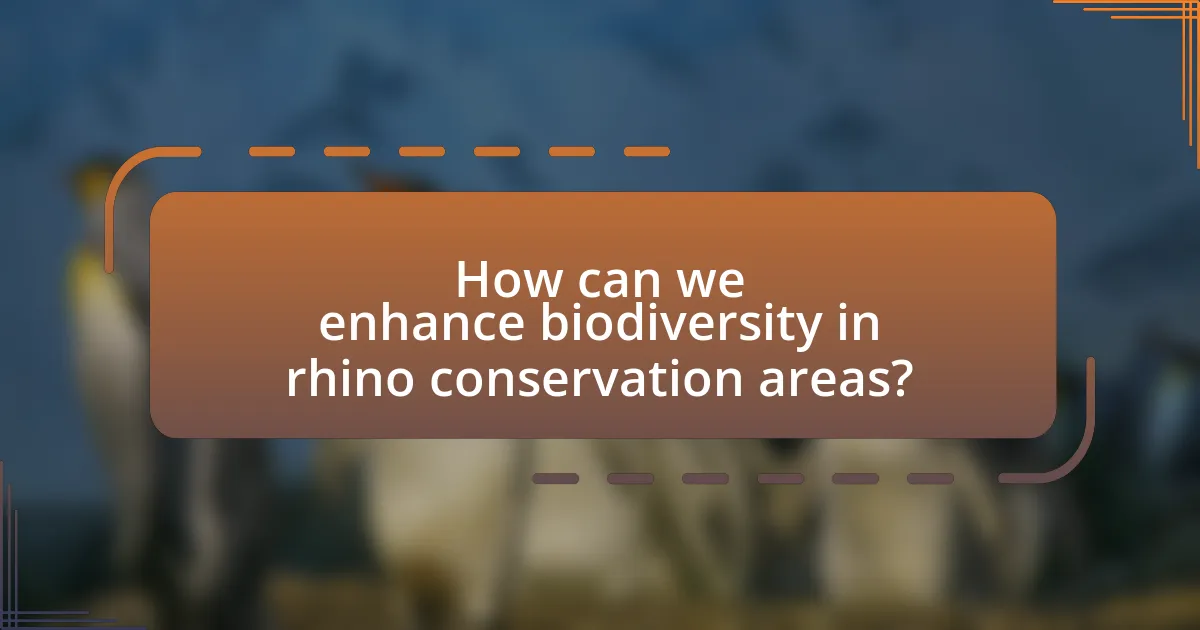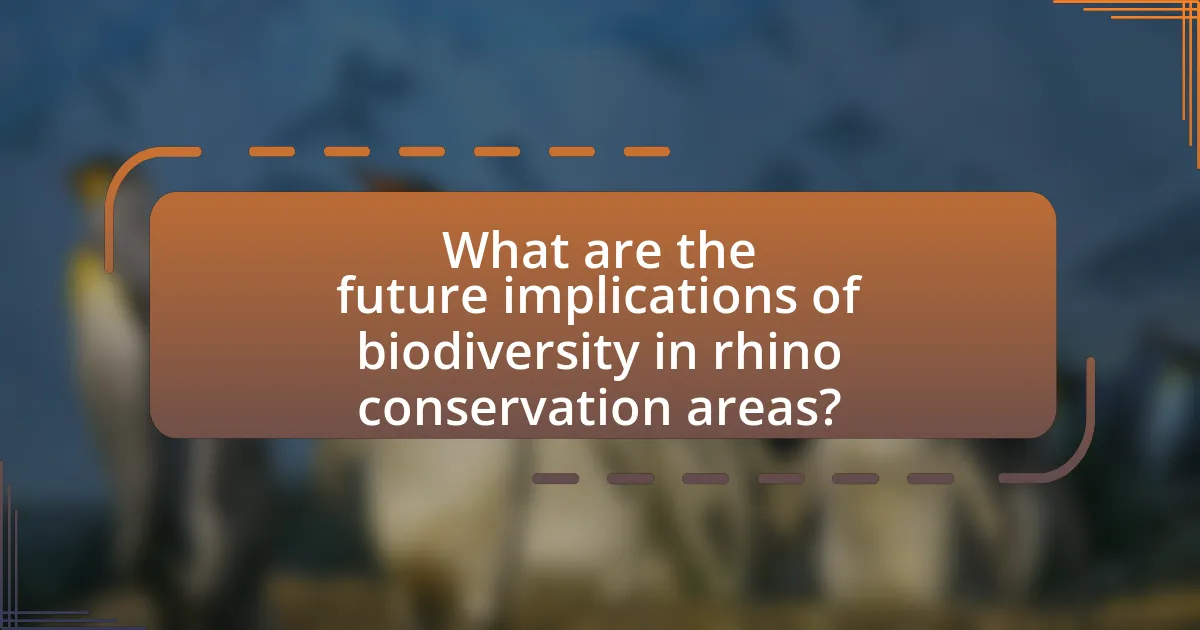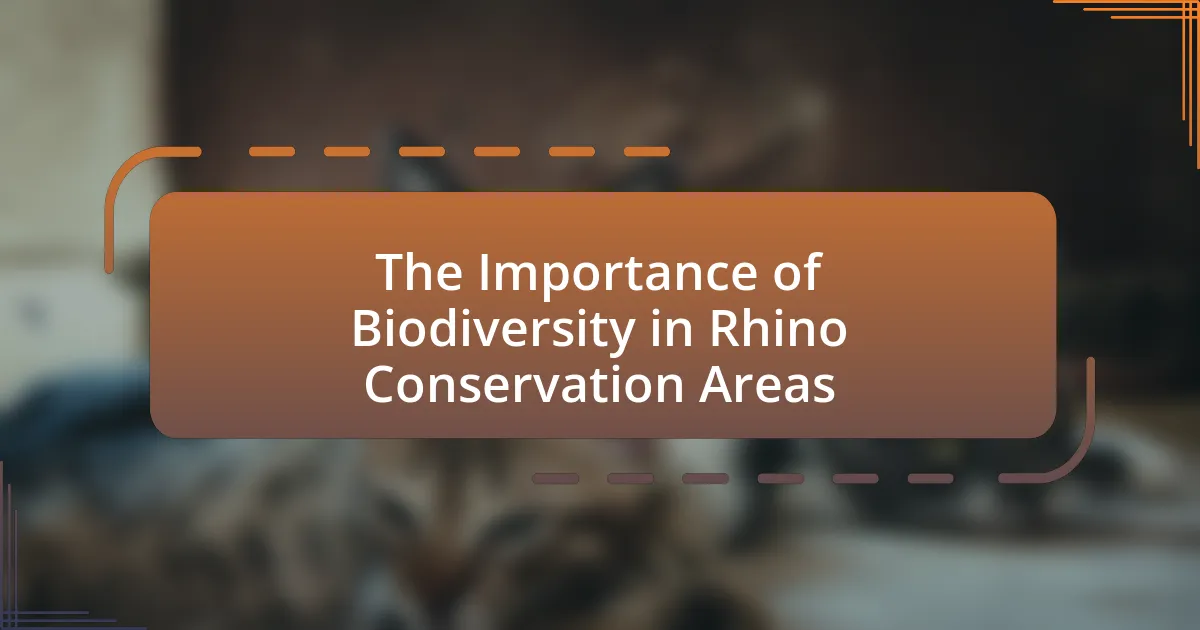Biodiversity plays a critical role in the conservation of rhinos by enhancing ecosystem resilience and stability, which are essential for their survival. A diverse range of species contributes to balanced ecosystems, ensuring adequate food sources and habitat structures necessary for rhinos. The article explores the importance of biodiversity in maintaining the health of rhino populations, the roles various species play in ecosystem stability, and the threats biodiversity faces in conservation areas. It also discusses strategies for enhancing biodiversity, the benefits of community involvement, and the implications of climate change on rhino conservation efforts. Overall, the article emphasizes the interconnectedness of biodiversity and rhino conservation, highlighting the need for effective management practices to sustain both.

What is the Importance of Biodiversity in Rhino Conservation Areas?
Biodiversity is crucial in rhino conservation areas as it enhances ecosystem resilience and stability, which directly supports the survival of rhinos. A diverse range of species contributes to a balanced ecosystem, ensuring that food sources, habitat structures, and ecological processes are maintained. For instance, healthy plant communities provide the necessary forage for rhinos, while a variety of animal species helps in pollination and seed dispersal, which are vital for plant regeneration. Studies have shown that areas with higher biodiversity are more effective in sustaining wildlife populations, including endangered species like rhinos, by providing a more robust habitat that can withstand environmental changes and pressures.
Why is biodiversity crucial for the health of rhino populations?
Biodiversity is crucial for the health of rhino populations because it ensures a balanced ecosystem that supports their survival and reproduction. A diverse range of plant and animal species provides rhinos with essential food sources, habitat, and protection from predators. For instance, healthy grasslands and forests, which are rich in biodiversity, supply the necessary nutrients and shelter that rhinos need to thrive. Additionally, ecosystems with high biodiversity are more resilient to diseases and environmental changes, reducing the risk of population declines. Studies have shown that areas with greater biodiversity tend to have more stable wildlife populations, which is vital for the conservation of endangered species like rhinos.
How does biodiversity contribute to ecosystem stability in rhino habitats?
Biodiversity contributes to ecosystem stability in rhino habitats by enhancing resilience against environmental changes and disturbances. A diverse array of species ensures that ecological functions, such as nutrient cycling and habitat provision, are maintained even when certain species are affected by stressors like climate change or disease. For instance, studies have shown that ecosystems with higher species diversity can recover more quickly from disturbances, as different species fulfill various roles that support overall ecosystem health. This stability is crucial for rhinos, as it helps maintain the habitats they rely on for food and shelter, ultimately supporting their survival and conservation.
What role do various species play in maintaining the balance of rhino conservation areas?
Various species play a crucial role in maintaining the ecological balance of rhino conservation areas by contributing to habitat health, food web stability, and ecosystem services. Herbivores, such as zebras and antelopes, help manage vegetation growth, which prevents overgrazing and promotes a diverse plant community that supports rhinos. Predators, like lions and hyenas, regulate herbivore populations, ensuring that no single species dominates the ecosystem. Additionally, smaller species, including insects and birds, contribute to pollination and seed dispersal, which are vital for plant reproduction and habitat regeneration. Research indicates that areas with higher biodiversity are more resilient to environmental changes, thereby enhancing the effectiveness of rhino conservation efforts.
How does biodiversity impact the survival of rhinos?
Biodiversity significantly impacts the survival of rhinos by maintaining ecosystem balance and providing essential resources. A diverse ecosystem supports various plant and animal species, which in turn ensures a stable food supply for rhinos, as they rely on specific vegetation for nutrition. For instance, the presence of diverse flora can enhance habitat resilience against diseases and climate change, which are critical for rhino populations. Additionally, a rich biodiversity helps in pest control and pollination, further supporting the health of the habitats rhinos inhabit. Studies have shown that areas with higher biodiversity tend to have more robust populations of rhinos, as these environments can better withstand environmental stressors and provide the necessary conditions for breeding and survival.
What are the direct benefits of a diverse ecosystem for rhinos?
A diverse ecosystem provides essential benefits for rhinos, including improved habitat quality, enhanced food availability, and increased resilience to environmental changes. The variety of plant species in a diverse ecosystem ensures that rhinos have access to a balanced diet, which is crucial for their health and reproduction. Additionally, a rich biodiversity supports a stable environment, reducing the risk of disease and promoting the overall well-being of rhino populations. Studies have shown that ecosystems with higher biodiversity are more productive and better able to withstand disturbances, which directly benefits rhinos by maintaining their habitats and food sources.
How does biodiversity influence the availability of food and water for rhinos?
Biodiversity significantly influences the availability of food and water for rhinos by maintaining ecosystem balance and resilience. A diverse range of plant species provides a varied diet for rhinos, ensuring they receive essential nutrients. For instance, the presence of different grasses and shrubs in savanna ecosystems supports the dietary needs of species like the white rhino, which primarily grazes. Additionally, biodiversity contributes to the health of water sources; diverse ecosystems filter and regulate water quality, ensuring that rhinos have access to clean drinking water. Studies have shown that areas with higher biodiversity tend to have more stable water supplies, which is crucial for the survival of rhinos, especially in arid regions.
What threats does biodiversity face in rhino conservation areas?
Biodiversity in rhino conservation areas faces threats primarily from habitat loss, poaching, and climate change. Habitat loss occurs due to agricultural expansion, urban development, and infrastructure projects, which fragment ecosystems and reduce available space for various species. Poaching, driven by the illegal wildlife trade, targets not only rhinos but also other species, disrupting ecological balance. Climate change further exacerbates these issues by altering habitats and affecting food and water availability, leading to increased competition among species. According to the International Union for Conservation of Nature, habitat destruction and poaching are among the top threats to biodiversity globally, underscoring the urgency of addressing these challenges in rhino conservation areas.
How do human activities affect biodiversity in these regions?
Human activities significantly reduce biodiversity in rhino conservation areas through habitat destruction, pollution, and poaching. Habitat destruction occurs primarily due to agricultural expansion and urban development, leading to the loss of essential ecosystems that support various species. For instance, the conversion of forests into farmland has been documented to decrease species richness by up to 50% in some regions. Pollution from agricultural runoff and industrial waste further degrades habitats, affecting water quality and soil health, which in turn impacts the flora and fauna dependent on these resources. Additionally, poaching for rhino horns not only threatens rhinos but also disrupts the ecological balance, as the removal of a keystone species can lead to overpopulation of certain herbivores, which can further degrade vegetation and habitat. These combined effects illustrate the detrimental impact of human activities on biodiversity in these critical conservation areas.
What are the consequences of reduced biodiversity on rhino populations?
Reduced biodiversity negatively impacts rhino populations by diminishing their habitat quality and food availability. When biodiversity declines, the variety of plant species that rhinos rely on for nutrition decreases, leading to malnutrition and lower reproductive success. Additionally, a lack of diverse ecosystems makes rhinos more vulnerable to diseases and environmental changes, as they depend on a stable habitat for survival. Studies have shown that ecosystems with higher biodiversity are more resilient and can better support large herbivores like rhinos, thus highlighting the critical link between biodiversity and the health of rhino populations.

How can we enhance biodiversity in rhino conservation areas?
Enhancing biodiversity in rhino conservation areas can be achieved by implementing habitat restoration, promoting native plant species, and establishing wildlife corridors. Habitat restoration involves rehabilitating degraded ecosystems to support a wider range of species, which has been shown to increase overall biodiversity. For instance, studies indicate that areas with diverse vegetation support more wildlife, including rhinos, by providing food and shelter. Promoting native plant species ensures that the ecosystem remains balanced and resilient, as these plants are adapted to local conditions and support local fauna. Additionally, establishing wildlife corridors facilitates animal movement between fragmented habitats, which is crucial for genetic diversity and population stability. Research has demonstrated that connected habitats lead to healthier ecosystems, benefiting both rhinos and other species.
What strategies are effective in promoting biodiversity?
Effective strategies for promoting biodiversity include habitat restoration, sustainable land management, and the establishment of protected areas. Habitat restoration involves rehabilitating ecosystems that have been degraded, which can enhance species diversity and ecosystem functionality. Sustainable land management practices, such as agroforestry and organic farming, reduce habitat destruction and promote biodiversity by maintaining ecological balance. The establishment of protected areas, such as national parks and wildlife reserves, safeguards critical habitats and provides a refuge for endangered species. According to the International Union for Conservation of Nature, protected areas cover approximately 15% of the Earth’s land surface and are essential for conserving biodiversity.
How can habitat restoration contribute to increased biodiversity?
Habitat restoration can significantly contribute to increased biodiversity by re-establishing native ecosystems that support a wider variety of species. Restoring habitats, such as wetlands, forests, and grasslands, enhances the availability of resources like food and shelter, which are crucial for various organisms. For instance, a study published in the journal “Ecological Applications” found that restored wetlands can support up to 50% more bird species compared to degraded areas. This increase in habitat quality and complexity allows for greater species diversity, as different organisms can thrive in the newly created niches. Additionally, habitat restoration can facilitate the movement and migration of species, further enhancing genetic diversity and ecosystem resilience.
What role do protected areas play in conserving biodiversity?
Protected areas play a crucial role in conserving biodiversity by providing safe habitats for various species, thereby preventing extinction and promoting ecosystem health. These designated regions, such as national parks and wildlife reserves, protect ecosystems from human activities like deforestation, pollution, and urban development, which can lead to habitat loss. According to the International Union for Conservation of Nature (IUCN), protected areas cover approximately 15% of the Earth’s land surface and are home to over 80% of the world’s terrestrial biodiversity. This significant coverage helps maintain genetic diversity, supports species migration, and fosters ecological resilience, which is essential for adapting to climate change.
How can community involvement support biodiversity efforts?
Community involvement supports biodiversity efforts by fostering local stewardship and enhancing conservation initiatives. Engaging communities in conservation activities, such as habitat restoration and species monitoring, leads to increased awareness and commitment to protecting local ecosystems. For instance, studies show that community-led conservation projects can improve biodiversity outcomes, as seen in the case of the Maasai Mara in Kenya, where local participation has led to a 30% increase in wildlife populations over a decade. This active participation not only empowers communities but also creates a sense of ownership, which is crucial for the long-term sustainability of biodiversity efforts.
What educational programs can raise awareness about biodiversity’s importance?
Educational programs that can raise awareness about biodiversity’s importance include school curricula focused on environmental science, community workshops on local ecosystems, and interactive online platforms that promote biodiversity education. These programs engage participants by providing hands-on experiences and factual information about the role of biodiversity in ecosystem health and stability. For instance, the “Biodiversity Education Program” by the World Wildlife Fund emphasizes the interdependence of species and habitats, demonstrating how biodiversity supports ecosystem services essential for human survival. Additionally, research indicates that experiential learning, such as field trips to conservation areas, significantly enhances understanding and appreciation of biodiversity among students.
How can local communities benefit from biodiversity conservation initiatives?
Local communities can benefit from biodiversity conservation initiatives through enhanced livelihoods, improved ecosystem services, and increased community engagement. These initiatives often create job opportunities in eco-tourism, sustainable agriculture, and conservation projects, which can lead to economic growth. For example, a study by the World Wildlife Fund found that communities involved in conservation efforts in Africa saw a 20% increase in income due to eco-tourism activities. Additionally, biodiversity conservation helps maintain ecosystem services such as clean water, pollination, and soil fertility, which are essential for local agriculture and food security. Engaging communities in conservation fosters a sense of ownership and responsibility, leading to more sustainable practices and long-term benefits for both the environment and the community.

What are the future implications of biodiversity in rhino conservation areas?
Biodiversity in rhino conservation areas is crucial for the long-term survival of rhino populations and their ecosystems. High biodiversity enhances ecosystem resilience, allowing these areas to better withstand environmental changes and threats such as climate change and poaching. For instance, diverse plant and animal species contribute to a balanced ecosystem, which supports the nutritional needs of rhinos and their habitat. Studies have shown that areas with rich biodiversity can sustain larger populations of rhinos, as they provide essential resources and reduce competition for food. Furthermore, maintaining biodiversity can lead to increased ecotourism, which generates funding for conservation efforts and local communities, thereby creating a sustainable model for rhino protection.
How does climate change affect biodiversity and rhino conservation?
Climate change negatively impacts biodiversity and rhino conservation by altering habitats and food availability. As temperatures rise and precipitation patterns shift, ecosystems become destabilized, leading to habitat loss for many species, including rhinos. For instance, the International Union for Conservation of Nature (IUCN) reports that climate change can reduce the range of suitable habitats for rhinos, making it harder for them to find food and reproduce. Additionally, increased frequency of extreme weather events can directly threaten rhino populations by destroying their habitats and increasing human-wildlife conflict as animals venture into human settlements in search of resources. This disruption in biodiversity not only affects rhinos but also the entire ecosystem, as each species plays a crucial role in maintaining ecological balance.
What adaptive strategies can be implemented to mitigate climate impacts?
Adaptive strategies to mitigate climate impacts include enhancing ecosystem resilience, implementing sustainable land management practices, and promoting biodiversity conservation. Enhancing ecosystem resilience involves restoring habitats and protecting natural areas, which can buffer against climate extremes. Sustainable land management practices, such as agroforestry and conservation agriculture, reduce soil erosion and improve water retention, thereby supporting both agriculture and natural ecosystems. Promoting biodiversity conservation is crucial, as diverse ecosystems are more resilient to climate change; for instance, studies show that areas with higher biodiversity can better withstand climate-related stresses, such as droughts and floods.
How can ongoing research contribute to understanding biodiversity dynamics?
Ongoing research contributes to understanding biodiversity dynamics by providing empirical data that reveals patterns of species interactions, ecosystem functions, and responses to environmental changes. For instance, studies utilizing long-term ecological monitoring have shown how species diversity influences ecosystem resilience, as evidenced by the work of Tilman et al. (2006) in “Biodiversity and Ecosystem Stability.” This research demonstrates that diverse ecosystems are better equipped to withstand disturbances, thereby highlighting the critical role of biodiversity in maintaining ecological balance. Furthermore, ongoing genetic studies help track population dynamics and genetic diversity within species, which is essential for conservation strategies, particularly in rhino conservation areas where habitat loss and poaching threaten biodiversity.
What best practices can be adopted for effective biodiversity conservation?
Effective biodiversity conservation can be achieved through habitat protection, sustainable land use practices, and community engagement. Habitat protection involves establishing and maintaining protected areas, which are crucial for preserving ecosystems and the species that inhabit them. Sustainable land use practices, such as agroforestry and responsible tourism, help minimize habitat destruction while promoting economic benefits. Community engagement ensures local populations are involved in conservation efforts, fostering stewardship and enhancing the success of initiatives. Research indicates that protected areas can significantly increase species richness and abundance, demonstrating the effectiveness of these practices in conserving biodiversity.
How can monitoring and evaluation improve biodiversity conservation efforts?
Monitoring and evaluation can significantly enhance biodiversity conservation efforts by providing data-driven insights that inform management strategies. These processes enable conservationists to assess the effectiveness of interventions, identify threats to biodiversity, and track changes in species populations and habitats over time. For instance, a study published in the journal “Biodiversity and Conservation” found that systematic monitoring of wildlife populations led to improved conservation outcomes in protected areas, demonstrating a direct correlation between monitoring efforts and increased species recovery rates. By utilizing this information, stakeholders can adapt their strategies to better address emerging challenges, ultimately leading to more effective conservation practices.
What collaborative approaches can enhance conservation outcomes?
Collaborative approaches that can enhance conservation outcomes include community engagement, partnerships between governmental and non-governmental organizations, and cross-sector collaboration. Community engagement fosters local stewardship, as seen in programs where local populations participate in conservation efforts, leading to increased compliance and support for conservation initiatives. Partnerships between governmental and non-governmental organizations, such as the collaboration between the World Wildlife Fund and local governments in Africa, have proven effective in pooling resources and expertise to tackle conservation challenges. Cross-sector collaboration, involving businesses and conservation groups, can drive sustainable practices that benefit both the economy and biodiversity, as demonstrated by initiatives that promote eco-tourism while protecting habitats. These approaches collectively contribute to more effective conservation strategies and improved biodiversity outcomes in rhino conservation areas.
